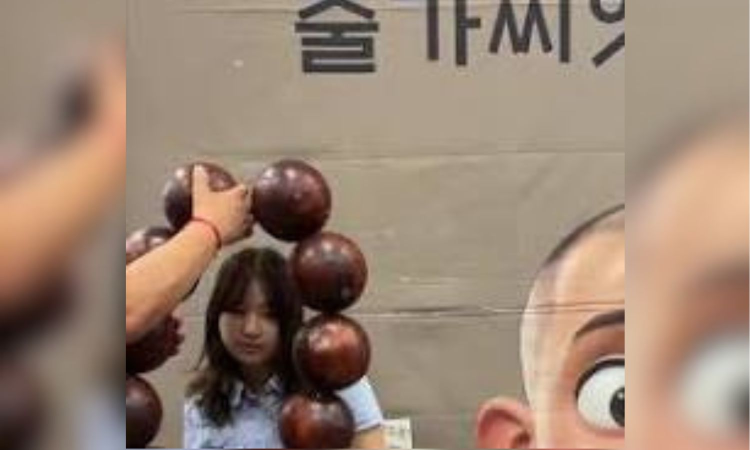Cultural remix: Buddhism meets pop culture
The convention is one of many ways monks are trying to show the modern relevance of a religion that some young people see as old-fashioned and confined to mountaintop temples.

Image: The New York Times
The most popular booths at the Buddhism convention in South Korea were the ones selling “Buddhistcore” merch. Attendees, mostly in their 20s and 30s, swarmed to grab key chains of the Buddha in neon with hearts for eyes, and streetwear-style T-shirts with slogans like “Shut up and meditate.”
“I came to buy a shirt, but they were sold out,” said Kim Mijin, 31, who instead snagged a bright red heart-shaped magnet reading, “Sentient beings, I love you.”
Now, she said, “I can show off to my friends that I was at this expo.”
Buddhism promotes nonattachment: reaching enlightenment by letting go of possessions and emotions. But at the Busan International Buddhist Expo in August, the Buddhism on display had been reimagined for young consumers — “Buddhism-core,” as organisers labelled it.
The convention is one of many ways monks are trying to show the modern relevance of a religion that some young people see as old-fashioned and confined to mountaintop temples. The Buddhist community has also hosted a dating reality show set in a temple, launched a musical troupe of monks and nuns styled after K-pop idols, and organised surfing lessons as part of temple tourism.
Many of the initiatives have spread quickly online and drawn crowds of young people. But it’s unclear if the attention will translate into longer-term engagement. “Attracting young people to events like the expo is one thing,” said Lee Sang-hun, a professor who heads an association of Buddhist-identifying academics. “Becoming an adherent is another hurdle.”
Buddhism was introduced to the Korean Peninsula via China around the fourth century and later became a state religion. There are thousands of temples across the country, and Buddha’s birthday is a national holiday.
But many Koreans now see Buddhism more as a cultural heritage than as a religion. In the 2015 census, 15.5% identified as Buddhist, down 7% from 2005.
Elsewhere in Asia, Buddhist communities are innovating too. Monks in Japan have opened bars and starred in fashion shows. Contemporary Buddhist musicians include a beat-boxing monk in Japan, a Taiwanese band that chants sutras in death-metal style, and Buddhist-themed rock groups in Malaysia and Indonesia.
Some of these efforts were inspired by worship music that has drawn young people to Christian megachurches, said Jack Meng-Tat Chia, a professor of Buddhist studies in Singapore. But Buddhism faces a steep challenge in South Korea, where Protestantism has overtaken it as the most popular religion. Christianity here is often associated with modernity, while Buddhism is seen as old-fashioned, Chia said.
Some young people at the Busan expo said they were trying to shake that idea. “South Koreans tend to see the religion as one for older people, encountered only at temples deep in the mountains,” said Ju Yeo-jin, 30, a vendor selling casual streetwear. “The Buddhism I’ve experienced is fun and cool. I want to convey that feeling.”
Many recruitment efforts are led by the Jogye Order, the country’s largest Buddhist sect. The Venerable Myo-jang, a monk and representative of the order, said its engagement campaigns have ramped up in recent years. Events that riff on cultural trends are particularly effective.
One example: this year’s celebration of Buddha’s birthday, with metallic balloons spelling out “Happy Birthday Buddha” and drinks decorated with lotus-shaped chocolates, mimicked the “birthday cafe” events that K-pop fans throw for their stars. “We try to do it in their language and at their eye level,” Myo-jang said.
He believes it’s working. Visitors at temples are trending younger, and his temple in Seoul established a youth group for the first time last year. Attendance at both the Seoul and Busan expos doubled this year, to about 200,000 and 100,000 people.
In addition to buying key chains and T-shirts, visitors tried meditation, ate vegan food, and sought advice from monks on subjects like relationship troubles.
But many said that although the expo made Buddhism seem cooler, they were unlikely to pursue the religion more deeply. “It did increase my interest in Buddhism temporarily, but I don’t think it’ll last for more than a couple of days,” said Lee Hana, 29, after taking photos in a wig of the Buddha’s curly hair.
Lee said some merchandise seemed more like a way for young people to borrow Buddhist slogans — about work-life balance, for example — than an expression of religious engagement.
The Buddhist community is grappling with how to balance this low-pressure approach with the desire for more practising adherents. “We are fundamentally a religion, so it would be nice if the number of Buddhists increased,” said Myo-jang, speaking at the Jogye headquarters in Seoul. “But a lot of young people tell us it’s good that we don’t force it.”
For now, “Buddhism-core” may remain less about enlightenment and more about neon Buddhas in sunglasses.
©️The New York Times Company



